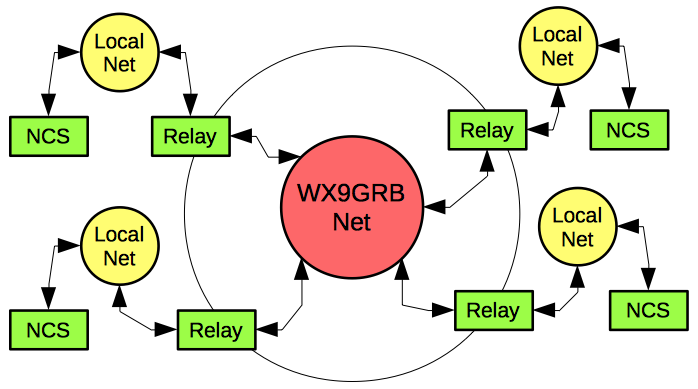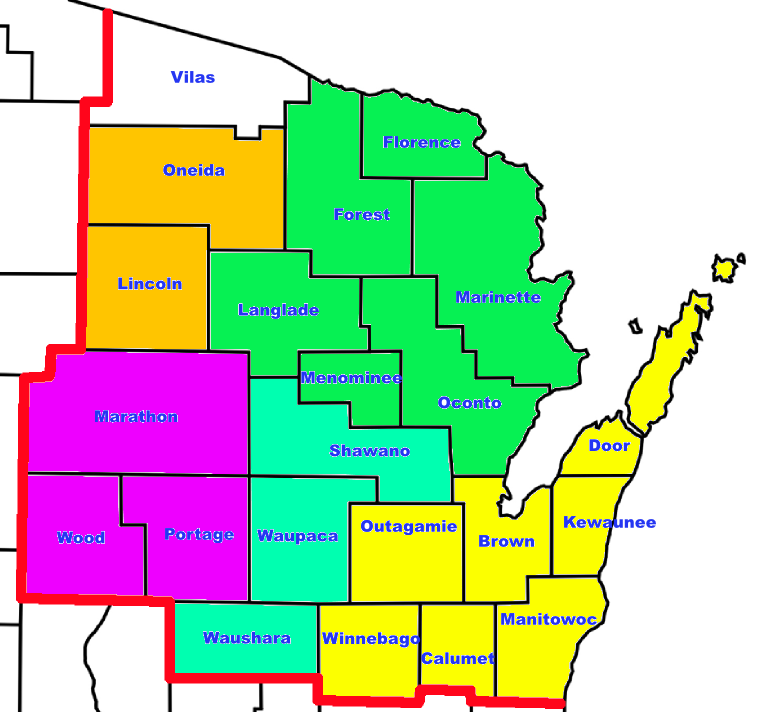WX9GRB Net Overview
The amateur radio station at WFO GRB (WX9GRB) will activate at the request of the National Weather Service... we do not activate for every thunderstorm, nor do we always activate during the overnight hours when spotter group participation may be minimal. This means that we usually activate for Severe Thunderstorm or Tornado Watch conditions, but not necessairly for an isolated single severe storm. If a WX9GRB net is not active, and you observe severe weather, please call the Spotter Hotline using the telephone number provided in the training classes.
WX9GRB is only able to accept reports for the WFO GRB's County Warning Area (CWA). This means that if you observe severe weather in another CWA, please contact weather programs in that CWA to make a direct report. If you cannot find them, then WX9GRB will accept the report, but please note that if we are busy, your report may be delayed reaching the intended office.
WX9GRB operates with a two-net structure as shown below.

As you can see, there are four major components to a weather net. Let's look at each one in detail.
Green Bay Weather WX9GRB |
Green Bay Weather WX9GRB operates on the coordination net on the repeater systems listed below. This net is restricted to Relay / Liaison stations, and on the rare exception, the mobile spotter who cannot reach a local net. All other spotting traffic should be kept on the local nets. |
|---|---|
Net Control Station NCS |
The Net Control Station (NCS) is the leader / coordinator of the local net. The NCS should not communicate directly with WX9GRB, as that is the Relay / Liaison station's responsibility. The NCS has significant responsibility to the local net, primarily the safety of the local spotters, and local storm conditions often prevent one person attempting to assume multiple roles. The NCS station should also not be deployed in the field -- they should be at a base station with backup power available. The safety of the local spotter group is the NCS's primary responsibility. |
| Relay / Liaison Stations | The Relay Stations have a very important role in a weather net -- they communicate information from WX9GRB to field spotters, and they also provide field reports to WX9GRB. Relay stations need to know about our criteria. Relay stations should not be spotters, and they should have base antennas so that they can interact with both nets with signal loss. They should also have backup power in the event commercial power is lost. Relay stations need to remain on a WX9GRB frequency once checked into the Net. There are times that WX9GRB needs to reach a local net with information that cannot wait. The relay station must be able to work with two frequencies at the same time. When a Relay station calls us, they should use their county, along with a one-word description of the type of traffic, such as "Winnebago County, Funnel Cloud". |
| Local Spotters | Local Spotters are members of the community actively storm spotting. They interact with their NCS stations, and study weather materials to keep themselves safe and informed during weather events. |
WX9GRB Nets are restricted to Liaison (Relay) Stations working with local spotter nets. Our net will only accept traffic from a spotter if a local net is not available, or if that spotter cannot communicate with a local net due to a communications hardship. A web page devoted to local nets may be found here.
WX9GRB Nets may be found on the following repeater systems in NE / NC Wisconsin:

Primary |
Secondary |
|
|---|---|---|
| North East | 145.47 PL 114.8 Suring |
|
| East | 444.775 PL 107.2 Green Bay (IRLP 4475) 146.76 PL 100.0 Chilton |
146.400 Simplex PL 123.0 (IRLP 4772 backup IRLP 4475 node) 147.075 PL 107.2 |
| West | 444.30 PL 114.8 (IRLP 4380 Wausau) |
146.82 PL 114.8 (IRLP 4709 Wausau) |
North |
146.64 PL 114.8 (IRLP 4618 Merill) | 444.30 PL 114.8 (IRLP 4380 Wausau) |
| "depends" | Determined by location of Relay Station |
A graphical coverage map may be found here. The map is calibrated for a home-like installation transmitting to the repeater.
Please remember that these repeaters are reserved for WX9GRB Liaison (Relay) Stations participating from the local nets. Liaison stations are welcome to use whichever hub repeater provides them the easiest / best signal into the network.
The general public is welcome to listen to these nets. Please ensure that your PTT is secured, so that you do not accidentally key up.
Do not crossband repeat these repeaters into other repeater systems.